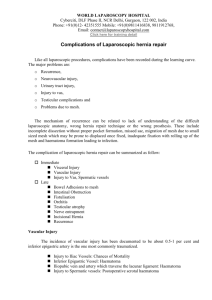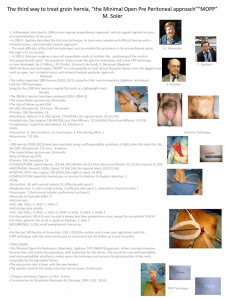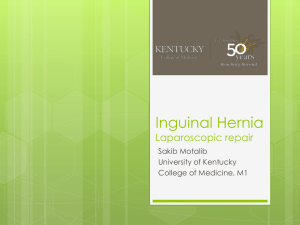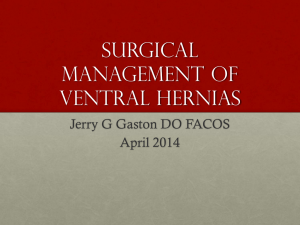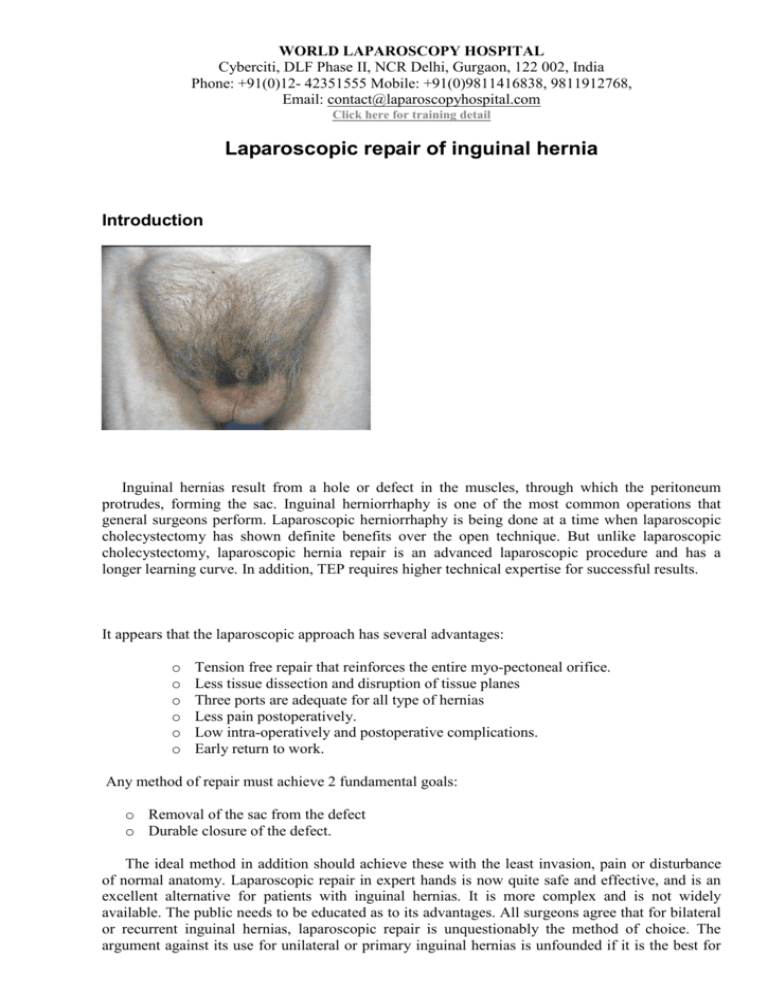
WORLD LAPAROSCOPY HOSPITAL
Cyberciti, DLF Phase II, NCR Delhi, Gurgaon, 122 002, India
Phone: +91(0)12- 42351555 Mobile: +91(0)9811416838, 9811912768,
Email: contact@laparoscopyhospital.com
Click here for training detail
Laparoscopic repair of inguinal hernia
Introduction
Inguinal hernias result from a hole or defect in the muscles, through which the peritoneum
protrudes, forming the sac. Inguinal herniorrhaphy is one of the most common operations that
general surgeons perform. Laparoscopic herniorrhaphy is being done at a time when laparoscopic
cholecystectomy has shown definite benefits over the open technique. But unlike laparoscopic
cholecystectomy, laparoscopic hernia repair is an advanced laparoscopic procedure and has a
longer learning curve. In addition, TEP requires higher technical expertise for successful results.
It appears that the laparoscopic approach has several advantages:
o
o
o
o
o
o
Tension free repair that reinforces the entire myo-pectoneal orifice.
Less tissue dissection and disruption of tissue planes
Three ports are adequate for all type of hernias
Less pain postoperatively.
Low intra-operatively and postoperative complications.
Early return to work.
Any method of repair must achieve 2 fundamental goals:
o Removal of the sac from the defect
o Durable closure of the defect.
The ideal method in addition should achieve these with the least invasion, pain or disturbance
of normal anatomy. Laparoscopic repair in expert hands is now quite safe and effective, and is an
excellent alternative for patients with inguinal hernias. It is more complex and is not widely
available. The public needs to be educated as to its advantages. All surgeons agree that for bilateral
or recurrent inguinal hernias, laparoscopic repair is unquestionably the method of choice. The
argument against its use for unilateral or primary inguinal hernias is unfounded if it is the best for
bilateral or recurrent hernias.
Indications of Laparoscopic repair of hernia.
The indications for performing a laparoscopic hernia repair are essentially the same as repairing
the hernia conventionally. There are, however, certain situations where laparoscopic hernia repair
may offer definite benefit over conventional surgery to the patients. These include:
*Bilateral inguinal hernias
*Recurrent inguinal hernias
In recurrent hernia surgery failure rate is as high as 25 to 30 per cent if again repaired by open
surgery. The distorted anatomy after repeated surgery makes it more prone to recurrence and other
complication like ischemic orchitis. In recurrent hernia the laparoscopic approach offers repair
through the inner healthy tissues with clear anatomical planes and thus, a lower failure rate. In
laparoscopic bilateral repair with three ports technique there is simultaneous access to both sides
without any additional trocar placement. Even in patients with clinically unilateral defect after
entering inside the abdominal cavity there is 20-50 per cent incidence of a contra lateral
asymptomatic hernia being found which can be repaired, simultaneously, without any additional
morbidity of the patient?
Types of laparoscopic Hernia repair:
Many techniques were used to repair hernia like:
o Simple closure of the internal rings
o Plug and patch repair
o Intraperitoneal onlay mesh repair
o Transabdominal preperitoneal mesh repair (TAPP)
o Total extraperitoneal repair (TEP)
Contra-indications of Laparoscopic repair of hernia.
o
o
o
o
o
Non-reducible, Incarcerated Inguinal Hernia
Prior laparoscopic herniorrhaphy
Massive Scrotal hernia
Prior pelvic lymph node resection
Prior groin irradiation
The technique of transabdominal preperitoneal repair was first described by Arregui in 1991. In
the Transabdominal Preperitoneal TAPP repair, the peritoneal cavity is entered, the peritoneum is
dissected from the myopectineal orifice, mesh prosthesis is secured, and the peritoneal defect is
closed. This technique has been criticized for exposing intra-abdominal organs to potential
complications, including small bowel injury and obstruction.
The totally extraperitoneal (TEP) repair maintains peritoneal integrity, theoretically eliminating
these risks while allowing direct visualization of the groin anatomy, which is critical for a
successful repair. The TEP hernioplasty follows the basic principles of the open preperitoneal giant
mesh repair, as first described by Stoppa in 1975 for the repair of bilateral hernias.
Patient selection:
The general anaesthesia and the pneumoperitoneum required as part of the laparoscopic
procedure do increase the risk in certain groups of patients. Most surgeons would not recommend
laparoscopic hernia repair in those with pre-existing disease conditions. Patients with Cardiac
diseases and COPD should not be considered a good candidate for laparoscopy. The laparoscopic
hernia repair may also be more difficult in patients who have had previous lower abdominal
surgery. The elderly may also be at increased risk for complications with general anaesthesia
combined with pneumoperitoneum.
If the patient is young or the hernia small, it does not matter how the hernia is repaired.
Many surgeons agree that for bilateral or recurrent inguinal hernias, laparoscopic repair is
unquestionably the method of choice.
RECOMMENDATIONS
PATIENT FIT FOR GA
BILATERAL – LS
RECURRENT – LS
UNILATERAL – LS/OS
STRANGULATED – OS
UNFIT FOR GA (SPINAL)
SMALL – LS/OS
LARGE – OS
LOCAL
OS
LS: Laparoscopic surgery
OS: Open Surgery
Trans-abdominal Pre-peritoneal repair of Inguinal Hernia
Port Position for TAPP.
Port position
Trans abdominal Pre Peritoneal
Anatomy
LIGAMENTS:
1. Median Umbilical
LigamentObliterated Urachus
2 Medial Umbilical
LigamentObliterated
umbilical arteries
3. Lateral Umbilical
Ligament- Inferior
epigastric vessels.
First identify Medial Umbilical
Ligament
Then Identify Lateral Umbilical ligament for Inferior epigastric
vessels
Anatomy
1
3
2 7
5
4
1. Medial umbilical ligament, 2.Inferiar Epigastric vessels, 3.Spermatic
vessels, 4.Vas deferens, 5.External iliac vessels in “Triangle of Doom”,
7.Indirect defect,
Triangle of Doom
1
3
2 7
5
4
1. Medial umbilical ligament, 2.Inferiar Epigastric vessels, 3.Spermatic
vessels, 4.Vas deferens, 5.External iliac vessels in “Triangle of Doom”,
7.Indirect defect,
Three important dangerous areas where stapling and electrosurgery should be avoided.
o TRIANGLE OF DOOM
o Iliac Vessels
o TRIANGLE OF PAIN
o GFN and LFCN
o TRAPEZOID OF DISASATER
o Abnormal Obturator artery.
Steps of TAPP:
o
o
o
o
o
o
o
o
Preparation of the patient
Creation of pneumoperitoneum
Insertion of port
Diagnostic laparoscopy and Dissection of the pre-peritoneal space.
Dissection of Cord structures.
Placement of the Mesh.
Closure of Peritoneum.
Ending the operation.
Preparation of patient
1.
2.
3.
4.
5.
6.
7.
Receive a general anaesthetic
Get Inserted Gastric tube and Foley urinary catheter
Position the patient on the table
Place the patient in supine position.
Position the table as to tilt head 15 degree down.
Paint thoroughly the operative area of skin
Drape patient such as to expose 2/3 of lower abdomen.
Creation of Pneumoperitoneum.
o Check Veress needle before insertion.
o
o
o
o
o
o
o
o
Check veress needle tip spring.
Confirm that gas connection is functioning.
Ensure flushing with saline does not block that needle.
Make a small incision just above the umbilicus.
Lift up abdominal wall and gently insert Veress needle till a feeling of giving away
Confirm position of needle by saline drop method
Connect CO2 tube to needle
Switch off gas when desired pneumoperitoneum is created and Remove the Veress
needle
Insertion of Port
o
o
o
o
o
o
o
o
o
o
o
Extend incision on umbilicus.
Insert 11mm Trocar and cannula (if using disposable check blade tip is functioning).
Point Trocar toward pelvic cavity
Lift abdominal wall and insert Trocar and cannula with sustained pressure till
reduction in resistance shows that you are inside peritoneal cavity.
Remove Trocar, leave the cannula.
Connect camera to telescope.
Connect light source
Do white balance.
Insert telescope.
Connect CO2 tube to telescopic port.
Two Lateral Port are Inserted two figures medially and inferior to each anterior
superior Iliac spine.
Dissection of the pre-peritoneal space
Steps of TAPP
Opening the pre-peritoneal space
•Incision begins just above and 4 cm
lateral to the outer margin of the deep
ring
•Peritoneum incised medially almost up
to the midline
•Epigastric vessels should be safe
guarded
Dissection of the pre-peritoneal space
Steps of TAPP
Dissection of pre-peritoneal space
Dissect the peritoneal flap
towards the iliac vessels
inferiorly and towards
anterior abdominal wall
superiorly.
Cooper’s ligament, arch of
transverses abdominus,
conjoint tendon and Iliopubic
tract should be seen.
Separate the elements of
the spermatic cord from the
peritoneal sac.
Dissection should be started with opening the peritoneum lateral to the medial umbilical
fold in order to identify Cooper’s ligament. Stopa’s parietalization technique should be used for
dissection of the spermatic cord from the peritoneum by separating the elements of the spermatic
cord from the peritoneum and peritoneal sac.
The important landmarks of laparoscopic hernia repair are the pubic bone and inferior
eipgastric vessels. Surgeon should use both blunt and sharp dissection and the sac is dissected off
the anterior abdominal wall. Once the sac is separated the next step is separation of sac from cord
structures and dissection for creation of proper lateral space for placement of mesh. Lateral limit of
dissection is the antero-superior iliac spine while inferior limit laterally is the psoas muscle.
Dissection should be avoided in the "triangle of doom" which is bounded medially by the vas
deferens and laterally by the gonadal vessels. The tacker application and application of
electrosurgery should be very careful at in the triangle of doom, triangle of pain and trapezoid of
disaster. In case of massive complete indirect scrotal hernias, no attempt should be made to reduce
the sac completely as it may increases the risk of testicular nerve injury and haematoma formation.
Sac if some time not possible to reduce completely after being reduced partially or transected is
ligated using an endoloop. In case of bilateral hernias, the procedure is repeated on the other side. A
15 x 15 cm mesh is placed which is fixed medially over the Cooper's ligament and pubic bone
using a tacker or anchor. No lateral slit should be made in the mesh and it should not be fixed
lateral to cord structures to prevent injury to lateral cutaneous nerve of thigh. The mesh in this
position covers the direct, indirect and femoral defects.
Placement of the Mesh
Few surgeon used to cut one corner of mesh.
o Cut the mesh in appropriate Size usually 15X15 Cm and one corner of Mesh should be
tailored.
o Roll the mesh and load backward in one of the port.
o Unroll it when it reaches in peritoneal cavity
o Tailored corner of mesh should be positioned infero-medially.
o Fix the mesh by stapling first its middle part three figure above the superior limit of the
internal ring.
Criteria for Laparoscopic Mesh
o Non Absorbable,
o Adequate size,
o Adequate memory,
With mesh duly stapled pneumoperitoneum is reduced to 9 mmHg
Closure of the Peritoneum
Peritoneum flap is replaced over the mesh and it is closed either by staple or suture.
Peritonization
It is Important that mesh should be completely covered by the peritoneum. Ideally
peritoneum should be opposed by overlap fashion and peritoneum defect is closed either by staples
or by continuous suturing and Aberdeen termination.
Ending of the operation.
At the end of surgery the abdomen should be examined for any possible bowel injury or
haemorrhage. All the instrument should be removed and then all the port. Telescope should be
removed at last after releasing all the gas keeping in mind that last port should not be pulled
without putting telescope or any blunt instrument in to prevent entrapment of bowel or omentum
and formation of adhesion or intestinal adhesion. Wound should be closed with suture specially
10mm wound.
Totally Extra-peritoneal hernia repair:
The technique of totally extra-peritoneal repair (TEP) of inguinal hernia was described even
before the TAPP technique, however, technical difficulties of working in closed space and
anatomy with the limited working space hindered its popular acceptance. The effectiveness of this
type of repair has been well established by the open operation of Stoppa.
Task analysis of TEP:
o
o
o
o
o
o
Preparation of the patient
Approach to preperitoneal space
Insertion of ports
Dissection of the pre-peritoneal space and cord structures
Placement and fixation of the Mesh
Ending the operation
Preparation of the patient
Preparation of the patient in totally preperitoneal Hernia repair is same as of the Trans
abdominal hernia repair. Knowledge of the anatomy of the abdominal wall muscle and recognition
of the transition zone that occur at the arcuate line of Douglas is very important for totally preperitoneal hernia repair.
Approach to Preperitoneal space.
In totally extraperitoneal repair of hernia main concern is to make an extraperitoneal space.
The extraperitoneal space is made possible by the fact that the peritoneum in suprapubic region can
easily be separated from anterior abdominal wall, hereby creating enough space for dissection.
An Incision is made just below the umbilicus and the anterior rectus sheath on the side of
the hernia is opened. Two-stay suture on each leaf of rectus sheath is placed and the rectus muscle
is retracted by two retractors downward towards symphysis pubis in an oblique fashion, we should
never cross the posterior fascia of the rectus muscle while dissecting. By fingered or swab we
should perform careful dissection, preperitoneal space will be found below the arcuate line of
Douglas.
Insertion of Port
An 11mm port is introduced without its sharp tip with a laparoscope in an angle of about 30 degree.
A small pre peritoneal pocket is created by manipulating laparoscope in sweeping manner.
Sweeping movement of telescope
A balloon dissector should be introduced with telescope and balloon is inflated for further
dissection of the pre-peritoneal space.
Balloon Dilatation is helpful in TEP
Finger of Gloves can be tied over suction irrigation instrument for making balloon dissector.
Insert two additional ports on one 5mm trocar on the midline at a midway distance between
the umbilicus and symphysis pubis and another 10-12 mm Trocar two fingers below and medial to
the right anterior iliac spine.
Dissection of preperitoneal space and cord structures in TEP.
I n totally extraperitoneal repair of hernia stopa’s parietalization technique is used for dissection
of the spermatic cord from the peritoneum by separating the elements of the spermatic cord from
the peritoneum and peritoneal sac should be done. Dissection should be continued until the
peritoneum has reached the iliac vessels inferiorly. Mesh in appropriate size usually 15X15 Cm is
used. Mesh should be rolled and load backward in one of the port. Mesh should be fixed by stapling
first in its middle part three finger above the superior limit of the internal ring. In totally
extraperitoneal repair we do not need much staple because peritoneum in not breached and once the
gas from pre-peritoneal space is removed it will place the mesh in its proper position.
Ending of the operation:
At the end of surgery the abdomen should be examined for any possible bowel injury or
haemorrhage. All the instrument should be removed and then all the port. We generally use vicryl
for rectus and un-absorbable intra-dermal or Stapler for skin. Adhesive sterile dressing should be
applied over the wound.
For More Information Contact:
Laparoscopy Hospital
Unit of Shanti Hospital, 8/10 Tilak Nagar, New Delhi, 110018. India.
Phone:
+91(0)11- 25155202
+91(0)9811416838, 9811912768
Email: contact@laparoscopyhospital.com
Copyright © 2001 [Laparoscopyhospital.com]. All rights reserved.
Revised:
.



